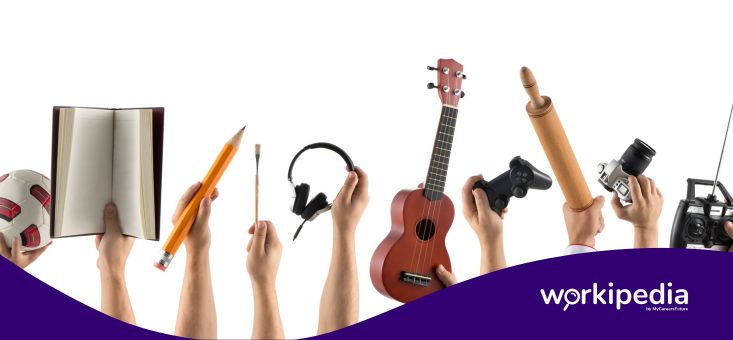In today’s competitive market, your job application and resume are the first things potential employers could see, and it’s obvious that you want to stand out positively as quickly and as much as possible.
Yet so many applicants skim past the hobbies and interests section, which ironically is what could distinguish you and add depth and character to your profile. Fleshing this section out will also provide insights into your personality beyond your professional qualifications. Ultimately, your hobbies and interests will give hiring managers a holistic view of who you are and highlight your various soft and hard skills.
If you’re still wondering why including hobbies can boost your job prospects and which hobbies best fit your desired position, we’ve got you covered. In this article, you’ll uncover the perfect hobbies to enhance your resume. We’ll provide some strategies, showcase examples, and explore best practices for adding hobbies.
Looking for a new role? Explore over 100,000 jobs available on MyCareersFuture now!
Why include hobbies and interests on your job application or resume?
Listing hobbies and interests on your resume may not seem important. But they can increase your chances of being called for an interview. Here are other reasons why you should consider adding them:
1. Showcases your soft and hard skills
Hobbies and personal interests can display soft and hard skills that employers value. For instance, participating in team sports reflects teamwork, leadership skills, and resilience. A hobby in blogging or podcasting shows excellent communication skills. These insights can strengthen your application.
2. Demonstrates your personality traits
Your hobbies provide a glimpse into your personality. It helps them assess the cultural fit. Enjoying outdoor activities might show what an adventurous and active person you are. Engaging in community service could reflect empathy and unselfishness.
3. Acts as a conversation starter
Hobbies and interests can lead to engaging discussions with a potential employer. They allow you to reveal a bit about what you do in your free time or who you are outside work. And helps you break the ice and connect with them on a more human level.
4. Indicates passion and dedication
Engaging in hobbies needs passion and dedication. Adding them to your resume demonstrates your ability to commit. This is an important quality hiring managers look for. It also highlights your strong work ethic and your high level of motivation.
5. Differentiates you from other candidates
Employers go through a lot of resumes. Many times, these have similarities in terms of qualifications and experiences. Adding hobbies and personal interests can make you stand out by adding a memorable and unique aspect to your profile.
Let us now explore how to choose the right hobbies to enhance your resume.
The right hobbies and interests for job applications and resumes
Putting hobbies and interests in your resume is not about filling up space. It is a strategic way to present a comprehensive picture of your candidacy. And it requires strategic thought. Here’s a guide to help you make the right choices for your interests and hobbies section:
1. Consider the job you’re applying for
Take a close look at the job description. What skills and qualities are the hiring manager looking for? Do any of your hobbies and personal interests help show these traits?
For example: if you’re applying for a job that requires teamwork, include a team sport or community activity that shows your ability to work as a team player.
2. Think about what skills and qualities the employer is looking for
Find a hobby that aligns with the company’s culture. Research the company. Read their mission statement. Check their social media accounts and look at any leisure activities they promote. This will help you understand what specific skills and qualities the employer is looking for.
For instance, the company you are interviewing at promotes outdoor team-building activities. Showcasing your passion for community clean-up projects reflects your commitment to civic responsibility, teamwork, and community engagement.
3. Choose hobbies and interests that align with the job requirements
Mention hobbies that are relevant to the job. This can show your passion for the field. For example, mention your interest in digital art when applying for a graphic design role.
4. Avoid controversial or potentially offensive hobbies and interests
Some hobbies and interests might be controversial. Others might be off-putting to an employer. Avoid including any hobby or personal interest that is related to politics and religion. This helps maintain a professional and neutral tone in your resume.
For instance, mentioning strong political affiliations could potentially create bias and affect your chances.
How to format the hobbies and interests section on your resume
The “Hobbies and Interests” section is typically placed at the end of your resume. It follows the sections like your work experience, education, and skills. This placement allows you to showcase your professional qualifications before sharing your personal interests.
When describing your hobbies and interests, keep it short and relevant. In a sentence or two, explain what each hobby entails. And, if applicable, highlight any skills or achievements related to it. This helps hiring managers understand how your personal interests may align with the qualities they are seeking.
Presenting your hobbies and interests in a clear and professional manner is essential.
Here are some tips for enhancing the hobbies and interests section of your resume
1. Use bullet points
Bullet points make your hobbies and interests easier to read. Each of these hobbies or interests examples should have their own bullet point.
2. Be consistent
Your hobbies and interests section should follow the same format as the rest of your resume. A good hobbies section should use the same font, size, and line spacing as the rest of your resume. Keep the style consistent.
3. Add a brief description
Add this if the hobby or interest isn’t self-explanatory. This will give the employer more context. It might also further showcase your skills and qualities.
4. Keep it short
While it’s important to provide context, keep descriptions brief. Do not go into unnecessary detail.
5. Prioritise
If you have several hobbies and interests, prioritise them based on their relevance to the job. Start by listing the most relevant hobbies first.
6. Review and edit
A good hobbies and interests section should be free from typos and grammatical errors. This shows the hiring manager your attention to detail and dedication to perfection.
Proper formatting of your hobbies enhances rather than distracts from your professional qualifications. Present them as complementary aspects of your professional profile.
This article is contributed by JobStreet by SEEK.














